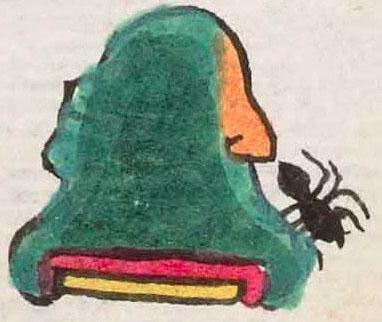Yacapichtlan (Mdz24v)
This compound glyph stands for the place name Yacapichtlan (today, Yecapixtla, Morelos). The nose (yacatl) (in profile, facing the viewer's right, and painted a terracotta color) is prominent, as is the tepetl (hill, mountain), which may be serving as a silent, visual locative in place of the typical tooth glyph (tlantli) which will normally stand for the -tlan ("near") locative suffix. The insect or spider below the nose has yet to be analyzed.
Stephanie Wood
The nose (yacatl) plays a phonetic role, rather than a semantic one. Likely, there is a peak, a point, or a ridge in the local landscape. The "pich" part of the place name may be represented by the ant(?) below the nose. A pichin is something small, perhaps like an insect? A bug or insect glossed "yacapich" forms another man's name in the Matrícula de Huexotzinco, which could provide the root of this place name, too.
Frances Karttunen has suggested that "pix" (from piya, to have, keep) could be at the root of this part of the place name. If so, the name could refer to a place that has a peak (since yacatl can refer to a peak). Perhaps yacapich- is used in a phonetic role as a near homophone to yacapix-. Given that the other Yacapichtlan glyph retains the "n" on the locative suffix, we are assuming that it was inadvertently omitted from this gloss. The contemporary town name is Yecapixtla; it is in the state of Morelos.
Stephanie Wood
yacapichtla
Yacapichtlan (Yecapixtla, today)
Stephanie Wood
c. 1541, or by 1553 at the latest
Stephanie Wood
hills, mountains, ridges, cerros, crestas, montañas, puntas, picos, insectos, bichos, nombres de lugares

yacapich(tli), a bug or an insect, https://nahuatl.wired-humanities.org/content/yacapichtli
yaca(tl), nose, https://nahuatl.wired-humanities.org/content/yacatl
pich(in), something small, https://nahuatl.wired-humanities.org/content/pichin
-tlan (locative suffix), place, https://nahuatl.wired-humanities.org/content/tlan
Cerca del Pico de los Bichos (o Insectos) (?)
Stephanie Wood
Codex Mendoza, folio 24 verso, https://digital.bodleian.ox.ac.uk/objects/2fea788e-2aa2-4f08-b6d9-648c00..., image 59 of 188.
The Bodleian Libraries, University of Oxford, hold the original manuscript, the MS. Arch. Selden. A. 1. This image is published here under the UK Creative Commons, “Attribution-NonCommercial-ShareAlike 3.0 License” (CC-BY-NC-SA 3.0).









